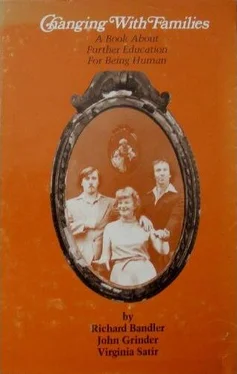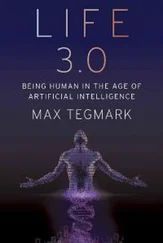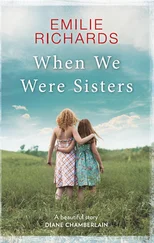We want to emphasize that the model for family therapy which we present here is designed to create experience. It is our belief that much time and effort is wasted creating models which people then use to replace experience. The families — the people who come to therapists for help — are then squeezed into the categories contained in the model, rather than being sensed and responded to creatively. We offer our model as a way to assist you to fully participate in the moving experience of changing with families, participating in the process of growth, of creating experience, of the family's pain and the family's joy. Our model, essentially, is a way of helping people-helpers to tune themselves in to the ongoing processes for growth of the families with whom they are working — a way of seeing, hearing, feeling, sensing, experiencing and responding clearly and creatively to the process of communication and change in family therapy.
Our conclusion from our experience and from our observation of the people we have known is that they have learned five personal "unfreedoms" which fetter them and bind them and which are mistakenly called civilized . We will list them in their corrected form, which will include that which was corrected:
(1) The freedom to see and to hear what is NOW instead of what should be, could be, was, or will be.
(2) The freedom to feel what is felt NOW instead of what should be, could be, was, or will be.
(3) The freedom to say what is NOW instead of what should be, could be, was, or will be.
(4) The freedom to reach out for what you want instead of what you should want, not having to wait for someone to offer it to you.
(5) The freedom to take risks in your own behalf instead of only waiting for a change in the situation to make it possible for you to have what you want for yourself.
To summarize,
When I can see and hear what is here now, feel what I feel now;
Say what I feel, think, hear, see now;
When I can reach out for what I want now;
And can take risks in my own behalf now;
When I can communicate all of this congruently now;
And can get feedback creatively now;
Then I am in a position to cope inventively with the situation outside of myself and the life inside me successfully –
NOW .
This book is our effort to translate people “unfreedoms” into freedoms.
In the following pages we will present our particular view of the manifold and exciting field of family therapy. As with any complex area of human behavior, the ability of therapists to perform family therapy far outruns their ability to explicitly understand and communicate to others what they specifically do when they practice family therapy. The purpose of this book is to attempt to make understandable to the reader the patterns of which we have become aware in our practice of family therapy and to catch up the theory of family therapy with its practice. Specifically, by extracting the patterns of family therapy, we hope to accomplish several things: First, by forcing ourselves to become aware of the patterns of our own behavior in doing family therapy, we will become more systematic in our work and more effective as people-helpers, and, second, we will be able to more effectively communicate our experience to others involved in family therapy so that a meaningful dialogue becomes possible among all of us as we help one another to become more successful and dynamic in our work.
The way that we hope to accomplish these goals is by creating an explicit model or map for our behavior in family therapy. By explicit model we simply mean a guide for behavior which can be used by anyone wishing to work as an effective family therapist. This guide for doing family therapy will be explicit if it presents the patterns necessary for a therapist to work in family therapy effectively and creatively in a step-by-step manner which makes it possible for the therapist to learn and to use these patterns. As we understand it, models or maps for behavior are not true or false, accurate or inaccurate, but, rather, they are to be judged as useful or not useful for the purpose for which they were intended. Since the model which we create here has as its purpose to assist each of you in becoming a more effective family therapist, we present it to you and invite you to take the model, the patterns we identify here, and to use them in your work in family therapy.
The first task which we need to accomplish is that of finding some common experience with which each of us, as family therapists, can identify. If we can succeed in this, then we can all begin together the journey to a better understanding of our work. If we can find this experience, then we can have a mutual reference point, or point of departure, from which we can build the model so that it will be useful for all of us. In a field as complex as family therapy, there are so many places from which we could start that it is difficult for us to choose among them. However, we have decided to begin with the patterns of verbal communication — the patterns by which the therapist and the members of the family communicate with one another in words. This is not a judgment that words are more important than, or have some priority over, other forms of communication such as body movements, tone of voice, etc., but simply a place — a set of experiences — which we all share and from which we can begin.
In order to assist each of you as you read this book to connect the words before you on this page with the actual feelings, sights, sounds, smells, tastes — with the excitement of working with a real family in your experience — we will proceed by presenting excerpts from transcripts to illustrate the patterns in our experience which we wish to most vividly model. Finally, as we begin, we would like to remind you to identify the patterns from the transcripts in this first part of the book; this part is designed simply to give you practice in identifying the patterns. Once we have identified a pattern, we will not identify it again each time that it occurs, but, rather, we will continue to move on to other patterns. In Part II, we will sort these patterns into natural groups which will help you to organize your experience in family therapy. We suggest that you simply sit back, breathe comfortably and use your skills to connect the words before you with your own experience.
PATTERNS OF EFFECTIVE FAMILY THERAPY LEVEL I
There are several important things which an effective family therapist assumes when he or she walks into a session with a family. First, the fact that the family has come to family therapy is a direct statement that they have hopes that they can change. This is true in our experience even when the family members are not aware of it. In fact, even in the extreme case of court referrals, the family has made a choice to come to therapy rather than selecting jail. Their presence in therapy, then, is a direct reflection of their hopes about continuing as a family, and that they believe at some level that they are capable of change.
Second, we assume, by the fact that the family is in our presence for therapy, that they recognize at some level that they need assistance in making those changes. In our experience, we have found it useful to assume that the family has the resources necessary to make those changes, and our task, then, is to help them tap those resources. Thus, one of our major goals is to assist the family members to recognize and accept the resources already in the family system, although they may be presently unacknowledged and untapped. The therapist will work to develop rapport and mutual trust with the family as a necessary first step in making changes. Without trust, no real risks will be attempted and no real changes will occur.
Читать дальше











